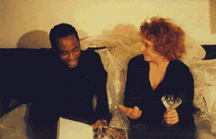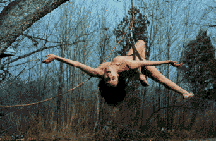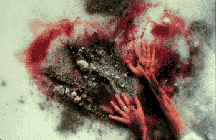Conversation with Carolee Schneemann (Part I)
by Odili Donald Odita
 |
Odili Donald Odita and Carolee Schneemann |
 |
Up To And Including Her Limits, 1973-76.
(Detail - First Action, 1973)
Performance/Installation;
Crayon on paper, rope,
harness, video, Super 8 film relay. |
 |
Homage to Ana Mendiata, 1986.
(Detail - Fragment of 32 Units)
Installation. |
PART I
Odili Donald Odita: I'm here in Carolee Schneemann's kitchen, speaking with her in a continuing series I'm doing with artists that challenge the tenets of art in our history. Carolee, in your work you use the nude body quite a bit. I would like to know why you use the nude body, versus say, a clothed body.
Carolee Schneemann: Do you have any idea, because I've written about it pretty extensively. Do you have any notion of why yourself?
ODO: I would have a notion of it, but my notion is more generalized. I have read only a few things about your work, I think that I'm also hindered by just a generation difference. I wasn't an active artist of the '60's, I was born in the '60's. I know your work through, peripherally through art school. Seeing some of the pictures that you commented as being reproduced over and over and over again, the scroll piece pictures. And only recently getting to know your work in a more in depth way through your exhibition at The New Museum.
CS: Well let me just go right into it, because it's not just using the nude body. Using my own body has several, let's say, art historical prongs to it, some of which you've heard me speak about before. The question of using the body as a form of my own material has been to see if I could penetrate the traditional conventions of art history in which the female nude was static and in effect, held by the brush on the canvas as a source of male rumination, power, and erotics. It was a question, when I felt that I had to incorporate my own body as one of my materials. It was at the time 1963, a question, could I disrupt, could I interfere with the projected meanings that had been stabilized around the female nude? And really the question that I was pushing for was, could I determine my pleasure in the body and situate my authority as an artist in its integration with various visual materials I would use? Really, what would it do to the rigid traditions of male castration fantasy that surrounded this female body--specifically with the cultural lack of a female pronoun in intellectual and ordinary language, and the lack of a realistic female genital represented by a woman's lived experience or depiction.
ODO: Besides your own experiences in the '60s' what was the motivating factor for you to divorce yourself from these notions of art where the nude body is a woman, and you're supposed to paint it and maybe flowers are supposed to sit next to it, and you're supposed to have wallpaper behind her?
CS: Well that image which you give as a kind of generalized acceptable image, has so many odd consequences. One, it relates to art having to be about beauty and soothing things, and not radical and disruptive. Two, that the iconic feminine can represent Nature: it's only through feminist analysis, and the breakdown of Western hierarchical aesthetics that the latency of these images has really been examined. And for that we owe a thanks to many disparate disciplines which are in themselves inadequate to fully carry meanings of feminism but which were strands that were able to substantiate investigation, such as Freud, Jung, semioticians... I mean, I hate to mention Lancan and Bataille, but they relate to areas of the abject and despised, and though they represent absolutely no coherent sense of female sexuality, they open the questions around sexuality.
ODO: For that space of silence and nothingness.
CS: Well, it gives you another set of hideous constructions to confront. And I'm very lucky in a way, that taking some of these issues on, feeling that I'm all alone with them when I start, and having this increasing coherence of cultural confirmation.
ODO: That's only happened in the last ten years, or fifteen years, or throughout?
CS: It happens throughout the history of my work with always a lag time, and with never any economic support along the way. But because there's a lag, the investment structures that help artists are never there for me. Such as grants, purchases, commissions. I've only had one commission ever in my life, I've only sold two works to U.S.A. museums with no change since my 1997 retrospective at the New Museum in NYC.
ODO: Did you get very much support from your male peers? I know you did a lot work with people like Robert Morris and Robert Rauschenburg. I don't know how much work you did with them, but I've seen specific pictures that speaks of the work you've done together.
CS: We were in a much smaller art world, at a time of intense, pleasurable communication, where an individual could represent to another body of artists a whole potentiality to change or shift what we had inherited as artists. And we all felt like we were chewing away, and breaking up these enormous bones that had been handed down to us. So we were communally transgressive...
ODO: The male and the female artists?
CS: Well, what happened was that the females started to fall by the wayside. The females really were treated differently. There wasn't quite enough room. We were what I call the ' cunt mascots.' We were extras, yeah. And you know, they didn't really need us. ' Oh, these women... Yes, this is fine, this is special, this is interesting. Oh, black artists, it's not just that they're different, they're very interesting... There's a value that we can exploit here....' This structure has always been, and this was rarely discussed. When you look at the guys that really get invested in, they tend to correspond to an Amerikana male heroics. So many of them, they're big, good looking, maybe they're charming drunks, they're powerful, they're a little bit out of control, they inhabit this whole realm that is extremely appealing to the men who have been investing in Western art. I'm not sure about all this, but it's definitely something working there, because I have to consider it, since my own exclusion and the exclusion of other women has been part of such a consistency.
ODO: So thorough, so thorough...
CS: So thorough... And black artists? Forget it. Actually in the '60s there was a lot of gender, racial merging and pulling together, because it was part of the breakdown of the separation of aesthetics and politics. We all had very desperate political cultural issues. The Vietnam war, civil rights, things that we were together on. And it was great, because there was such fluidity, and to see it disappear, that's been a horror.
ODO: After these things have settled, like the tensions and the changes in the '60s, basically?
CS: Well, what happened in the '70s was black separatism, and feminist separatism, we all had to get away from the white guy. And black artists had to get away from everybody white. And in order to define our own issues, the separatism became a real force field. We didn't want it, but we had to go there.
ODO: Could you briefly explain what is happening in the piece Olympia?
CS: You're talking about Site, Robert Morris' piece Site? I think it was '64, because I was doing Meat Joy at the time, which I felt might be a major visionary confabulation of lived action and extended visceral materials, that I considered would confront my guilty culture. And at the same time Bob Morris and I were doing improvisation, spontaneous improvisation to see if we could develop a work together in the basement of Judson Church as the Judson Dance Theater was becoming a form of collaborative association in itself. What I wanted was a lot of muscular interchange in the space, to explore each other's weights and balances. I was working on exercisers concerning exchanges of gravity and weight, who was more physically powerful, how you yield, how you exchange pushing, pulling, grabbing, how you take responsibilities for one another's bodies, and we were doing that. Bob came to rehearse one day and said, ' Come on down to Grand Street, to my studio, I have another idea.' And 'the idea' had me lying on this little board, while he moved the 6' by 8' plywood panels around. And it had a vivid surprise because the initial image you saw was very minimalist and formal, you just saw a 6' x 8' board. But there were actually three boards, and I was hidden behind them naked, balanced on this little rack. So my job was just to keep my head down, so I wasn't sticking up over the panels, when they were horizontal. And as he lifted the last one I raised myself on the small shelf to be revealed, stained white with a little black cat collar on my neck. A representation of Olympia. Now for me this was another fated collaboration with a male friend and associate in which something I had never anticipated happened, and I went into it to see how it would be, and with Olympia as the Site, I was unexpectedly immobilized and historicized.
ODO: Was he making any critique at all on your state, on your position?
CS: I don't know. We didn't know. I think he was making an art historical critique that had no feminist alignment. Many years later when Bob has his retrospective at the Guggenheim... You know, we're good friends. He said, ' I'm thinking of restaging Site, but I guess we shouldn't perform ourselves this time.' I said, ' You know, I'll think about it.' And then I met Dorothea Rockburne, and she said, ' Oh, well, obviously the way to go this time is that you stain Bob white and put a little collar on his neck. And he lies on the board and you move the panels around.' I said, ' Yeah, that's right. I'll propose that to him.'
ODO: Did you propose it?
CS: Well, he went and got young, new people to redo it, and it felt very dead to me when I saw it. I don't know whether it was being taken out of the originating action and imagery that was clouding my vision of it, but it didn't feel... I mean even for us, the latent, hidden tensions in it, probably made it very alive and special. If you look at photos of Site, I always have a grim face and filthy feet. Now, one of the things you asked me earlier was what were the influences in the early '60s. One was being told at art school, even though I had full scholarships and fellowships, that I was unteachable because I was working obsessively. I wanted to learn absolutely every hard, rigorous discipline that I could learn. I was someone who had to make images since I was four years old, that was just absolute bedrock. Then in the '60s, reading Artaud, Theatre and its Double, Wilhelm Reich, and De Beauvoir's, The Second Sex, and exploring an equitable, passionate relationship with another artist, James Tenney, the composer.
ODO: Can you explain the change that happens in your work from the '60s, into the '70s and '80s, where, in the earlier part you were dealing with a group ensemble, and it looks like group spectacle, i.e., Meat Joy, to the later work that comes up in the '70s and '80s. A particular piece would be Up to and Including Her Limits?
CS: Okay, Thaemes Crawling, 1970, London, is the last group work that I do. And you can see here, we're all naked in movement combinations. We blow up these huge inflatable tubes--which were popular materials at the time--and the swelling tubes force the audience out. We inflate them up from the front of the performance area to the back, so that people are actually having to get up and escape the pressure of these huge inflated plastic shapes that are pushing into the space. They were enormous. I'm in London because I flipped out at the end of the '60s, like many people did. The Vietnam war is not over, it's still going on, people are so physically stressed and crazed. Martin Luther King is assassinated, the second Kennedy brother, Robert, is assassinated, Warhol was shot by Valerie Solanas the same week, they were crowding headlines, Robert Kennedy and Andy have the same headline overlap, Hendrix hasn't dies yet, Morrison has probably died, some of the Panthers are shot, the WeatherPeople are blown up and disappeared, it feels like this whole place is just going to blow. Couples separate and split, draft resisters are imprisoned, Rauschenberg and Steve split, Tenney and I split, people run away to communes, communes break apart. I ended up in Europe, wandering around with my cat, Kitch, really penniless; living off of handouts. In London I gradually started to work again. But about the time that I was ready to be able to come back to the States, I realized that I was going to stop all group work, all idealized expectation of the meaning of community and group, that whatever I had to do I had to get rid of performance a fixed audience, rehearsals, performers, fixed durations, sequences, conscious intention, improvisation, technical systems and cues, a central metaphor or theme. 1973, I come back to the United States to this loft, with my English partner, Anthony MaCall, and the aged cat, Kitch. So, I had started working suspended on a rope in the film projector light with crayons in my extended hand.
ODO: Why the rope though? With this story you just told me, I just think of rope and hanging myself.
CS: That's very funny and smart, because I never thought of that, but you're right. Here's the last piece I ODO: April '69, before I leave New York City at 'A New Poets' Theatre' I hang myself symbolically. This is an important performance, titled 'Expansions.' Vito Acconci has not yet performed physically, he seems entranced by my actions. As part of this configured set of events, Vito reads his poetry. When I come back from Europe in '73, there are many performance artists, Vito as well. I felt that there was some sort of permission that my actions through the 1960's allowed. But you're right, the rope is there. The rope has already been in Water Light/Water Needle, the aerial performance in 1966, then the rope comes back as the solitary companion in what's first called 'Trackings,' and then becomes, Up to and Including Her Limits. It's anti-gravitational. I completely concentrate on the rope and as I'm suspended, as if I'm weightless in space, then some very mysterious energy goes through my musculature into the rope, the rope begins to move. Like one of the those magic Ouiga lines, and it's quite terrifying and wonderful. I didn't know what I was doing and I never thought it would matter to anybody at all. It was a way of drawing, I wanted to get back to drawing.
Part II
Copyright ©1998 PLEXUS Art and Communication & the Authors All Rights Reserved
|